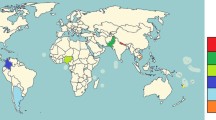Abstract
The emerging changes in healthcare significantly impact structure of surgical training. To achieve parity in surgical training globally significant work needs to be done in developing nations. The aims of this study are to identify and evaluate the current surgical training system in India and also examine the surgical training system of residents from India and compare the results against the US training system, to suggest changes for parity. On-site observations and cross-sectional survey of residents and staff from 22 institutions in India were done. Results were compared with the current US training system. Difference in pattern of surgical training and lack of coordination in curriculum was noted. Contradictory responses were noted for didactic teaching. No guidelines were mentioned for minimum number of surgical case required or certification courses. No work hour restrictions were followed, and supervision was ill defined. Residents were highly interested for fellowships and experience from the US medical system. Results revealed discordance in surgical training within the evaluated country. However, the two training systems studied have their own pros and cons. We strongly feel that incorporation of certain aspects of the American residency can aid in progression of the Indian training system.




Similar content being viewed by others
References
Zhang WG (2005) Facilitating residency training in China with the medical education experiences of America. Med Educ (China) 1(2):77–80
Sachdeva AK, Bell RH, Britt LD et al (2007) National efforts to reform residency education in surgery. Acad Med 82(12):1200–1210
Swanson AG (1974) The genesis of the coordinating council on medical education and the liaison committee on graduate medical education. Bull N Y Acad Med 50(11):1216–1221
Sachdeva AK (2007) The changing paradigm of residency education in surgery: a perspective from the American College of Surgeons. Am Surg 73(2):120–129
Accreditation Council for Graduate Medical Education. Common program requirements. Available at: http://www.acgme.org/acgmeweb/Portals/0/dh_dutyhoursCommonPR07012007.pdf. Accessed March 15, 2013
Ananthakrishnan N (2011) Distribution of postgraduate medical seats in different disciplines: is there rationality in decision making? Natl Med J India 24(6):365–367
Gupta A, Kumar S, Mishra MC, Kumar S (2006) Surgical residency program: training, teaching and evaluation in general surgery - a peer opinion poll in five medical colleges in northern India. Indian J Surg 68:310–315
Bass BL (2007) Fundamental changes in general surgery residency training. Am Surg 73(2):109–113
Accreditation Council for Graduate Medical Education, authors. ACGME Resident Duty Hours Task Force update. [Accessed June 1, 2010]. http://www.acgme.org/acWebsite/home/nascalettercommunity10_28_09.pdf
Accreditation Council for Graduate Medical Education. Program Requirements for Residency Education in Surgery. ACGME-approved: October 1, 2011; Effective: July 1, 2012 ACGME approved focused revision with categorization: September 29, 2013; effective: July 1, 2014
Vassiliou MC, Kaneva PA, Poulose BK, Dunkin BJ, Marks JM, Sadik R, Sroka G, Anvari M, Thaler K, Adrales GL, Hazey JW, Lightdale JR, Velanovich V, Swanstrom LL, Mellinger JD, Fried GM (2010) Global assessment of gastrointestinal endoscopic skills (GAGES): a valid measurement tool for technical skills in flexible endoscopy. Surg Endosc 24(8):1834–1841
Seymour NE, Gallagher AG, Roman SA, O’Brien MK, Bansal VK, Anderson DK et al (2002) Virtual reality training improves operating room performance: result of Randomized, double blind study. Ann Surg 236:458–464
Author information
Authors and Affiliations
Corresponding author
Additional information
Publisher’s Note
Springer Nature remains neutral with regard to jurisdictional claims in published maps and institutional affiliations.
Rights and permissions
About this article
Cite this article
Mittal, V., Kaushik, M., Bhullar, J.S. et al. Surgical Education (Developed vs Developing Nations), Disparities, and Future Directions: Fulbright Project Survey Report. Indian J Surg 81, 383–390 (2019). https://doi.org/10.1007/s12262-019-01901-8
Received:
Accepted:
Published:
Issue Date:
DOI: https://doi.org/10.1007/s12262-019-01901-8




